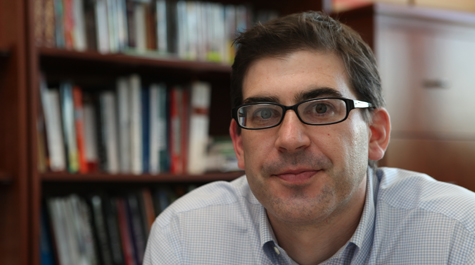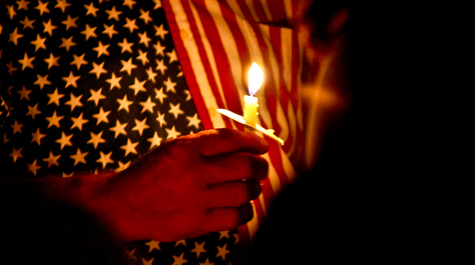Teaching 9/11, 15 years later
Since 2003, Jeremy Stoddard, William & Mary associate professor of education, along with Diana Hess, dean of the University of Wisconsin-Madison School of Education, have been researching the ways in which the September 11, 2001, terrorist attacks are included in high school curriculum and state standards. In light of the 15th anniversary, W&M News sat down with Stoddard to find out what’s changed in 15 years, and what the future of 9/11 education looks like.
How did you first get involved with researching 9/11 curricula?
Diana had started the project when I was a grad student because, for the first anniversary of 9/11, many different groups were coming out with special curricula for teaching kids about 9/11. The first study included a group of grad students analyzing these curricula, which then expanded into looking at how the first edition of textbooks after 9/11 portrayed the event and aftermath. We looked at a second round of textbooks five years later to see what had changed and what had stayed the same, because by then the US had invaded Iraq as part of the War on Terror. Mainly, we wanted to find out how 9/11 was being described, what caused it, and what the US and global response was to it. In particular, we were interested in what students would be engaged in related to the controversies that emerged post 9/11.
How did the earliest post-9/11 textbooks portray the attack?
What we saw in the earliest editions was the inclusion of a special section at the back of the book, and it was typically much more narrative, emotional and patriotic, and less a description of what happened compared to most of the history in the book. We also found that most textbooks don’t actually have a good description of what actually happened on that day. Major details are missing. We compared it to the way Pearl Harbor is portrayed, because they’re sort of similar in that both were surprise attacks that led to the U.S. entering into a long war or conflict. A lot of times, there is more detail about what happened at Pearl Harbor – like what caused it, who was responsible and how many people were killed – than actual details about 9/11.
Why do you think that is?
It was written in the moment. One thing we find is that history textbooks are hard to write while things are still going on. Until something is resolved and you have that distance of time to look back on the event, it’s really hard to do.
What resources are available to teachers today?
There’s actually a lot of online resources available for teachers and we’ve found that it’s across the ideological spectrum. The Newseum in Washington, D.C., just released an online curriculum, called Freedom in the Balance, which takes more of a historic look at issues relating to 9/11, so they would compare an issue like freedom of speech or freedom of assembly during previous eras and events that happened in response to US government policy after 9/11. There is also a civic education group called Choices which engages students in U.S. foreign policy simulations, and many of the lessons are related to the response after 9/11, like the war in Afghanistan. The 9/11 Memorial and the 4 Action Initiative, which was founded by families of the victims of 9/11, also have a set of high quality lessons for K-12 teachers available.
How does 9/11 education differ across states?
In a 2011 study of state high school social studies standards, we found content related to terrorism and 9/11 to be included widely. However, since that time, we have seen that 9/11-related standards are being left out from updated state standards, but I think that is largely because some states are shifting to common core standards and the C3 social studies framework (a national curriculum), which is less about specific facts or topics the students should learn and more about how they are learning it. Typically, though, I think the closer you are geographically to where 9/11 happened, the more you are going to have it included in the curriculum, as well as more of the patriotic, memorial side, whereas in a state like Washington, their curriculum is more about the policies and controversies that came out of 9/11.
How do textbooks define terrorism?
One thing we noticed was that even within one textbook the definition isn’t consistent. A lot of them will say it’s violence or a threat of violence against civilian population targets for political gain. That’s a very old school definition of terrorism. But then they would include the U.S.S. Cole (a naval warship) bombing and the U.S. Marine barracks bombing in Lebanon as examples, but those are military targets. We also saw a lot of textbooks post-9/11 focused solely on international examples of terrorism, primarily those that originate from the Middle East, and not the Unabomber or the Oklahoma City bombing. The definition of terrorism over the years seems to be shifting, and that’s because terrorism itself is a contested concept.
What’s an effective way to educate students on terrorism?
There’s a model we use in schools, especially middle schools, called the concept formation model, and it’s essentially being able to make generalizations based on a bunch of examples. Terrorism is a concept, so what we want is to actually have kids engaged in trying to define it so then they would better understand how contested it is and how difficult it is to actually label an attack an act of terrorism or not.
As the years continue to pass, how do you think 9/11 education will change?
I think we’ll probably see the memorialization part fade over time and it will likely become taught as an important day in history, like Pearl Harbor. But I think the interesting question is, because this is the longest the U.S. has been actively at war —15 years in Afghanistan — how is that going to be framed and remembered? With the Iraq War, textbooks basically erased the original reasons the U.S. went in (weapons of mass destruction) and made it all about regime change and Saddam Hussein. You would think the decision would be portrayed as more controversial. That’s something that we keep studying — how long does it take before you can safely say as a teacher that something was controversial? We hope, in the future, that all state standards would be shifted to say that students will engage in contemporary controversial foreign policy issues so teachers will feel empowered to do that. The new California State Social Studies Standards (2016), which utilizes the C3 inquiry framework (the social studies version of the common core) does just that.
















